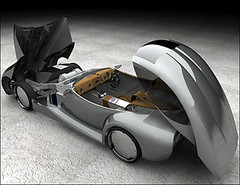
I'm a sucker for a sleek sports car. The rational part of my brain tells me that if we, as a society, don't overcome our obsession with automobiles, our rapid slide toward an unbearable tropical greenhouse climate will accelerate. But, from the time I was thirteen years old and discovered a stash of Car and Driver and Road and Track magazines in the garage of the home my family was renting, I was hooked. The photos of Sunbeam Alpines, Austin Healy 3000's, Morgan roadsters, Triumph TR-3's, and other four-wheeled exotica created a deep-seated love of sports cars that has yet to ebb.
So, although I will probably never own a Tesla or Morgan Lifecar (shown in the photo and styled after the Morgan-8 roadster), I think that the technologies that these automotive marvels are introducing are our best bet for preserving some measure of high-speed, independent mobility in the future. I also think that we should shift our transportation more toward mass transit, bicycling, and walking, with maybe a hybrid electric motorcycle thrown in for good measure, but we have the roads, we have the parking lots. Let's use them wisely as we transition to a people-oriented society rather than one where carbon-emitting motor vehicles dominate.
The Morgan Motor Company has been around since 1906, but their new fuel-cell powered sports car is an undeniable show stopper. It travels 250 miles per tank of hydrogen, accelerates from 0-60 in roughly 7 seconds, tops 90 miles per hour, and is being unveiled at the upcoming Geneva Motor Show on the 6th of March. Morgan will gauge production plans based on the response. As discussed in a BBC News article, Green sports car set for launch, the car was designed to minimize weight, which precludes including some features that typical car owners are accustomed to:
It also doesn't have any of the "luxuries" such as a stereo, central locking or even airbags, found on many modern cars.
"The objective is to get the weight down to 700kg."
There are also other notable omissions such as a gearbox and - as the fuels cells produce little noise - the roar of an engine.
"We may have to supply headphones with the sounds of a five litre V8 linked to the throttle pedal," said Mr Parkin.
Critics will point out that hydrogen fuel cells are a storage system, not a form of energy, but this critique ignores much work that is being done to provide a decentralized means of accumulating energy through wind turbines, solar panels, and other energy sources. What's wrong with driving a car that runs from hydrogen produced from a wind turbine on your garage roof, as described in More Wind Power!. A hybrid approach may be our best means of coping with diminishing fossil fuel reserves.
Using more advanced technologies, electricity from wind turbines can be stored by compressing or heating substances in tanks. One of the most promising ways to store surplus wind power is by producing hydrogen. Hydrogen can be stored under pressure in tanks, to provide fuel for industrial or domestic use or in cars, all without creating pollution. As discussed in more detail in an earlier article, electric vehicles can also run on Lithium-ion batteries that can be recharged from the solar panels on top of the roofs under which they are parked.
Anyway, more electric cars means that we need to generate more electricity, and wind power is one of the easiest and cleanest ways to do so. We can choose the times when best to recharge the batteries or produce the necessary hydrogen, so we can do so when it's windy and when there's little further demand, so it will take little or no electricity away from other usage. Look at it this way and claims that wind power was unreliable and that hydrogen was inefficient do not hold.
Critics will always be found for any proposed transportation solution that doesn't fit their personal intellectual blinders. I personally think that smart technology applied in ways that minimize environmental impact and lower carbon emissions can set us on the road to reversing global warming while still enjoying the occasional top-down drive through the countryside.